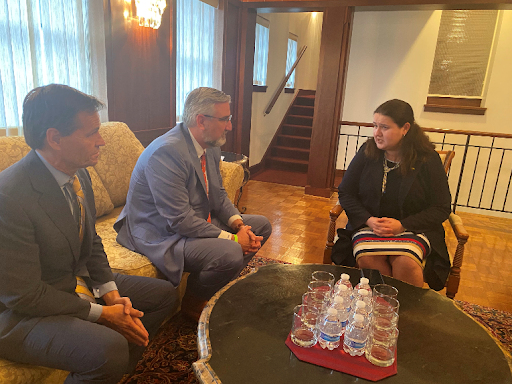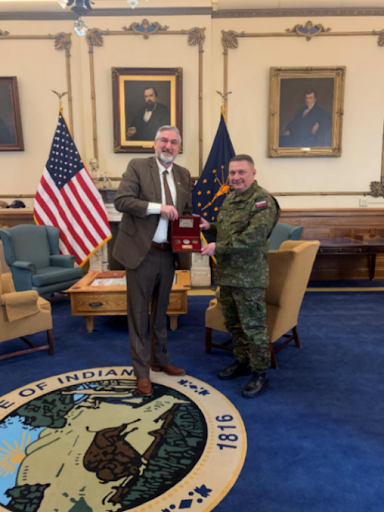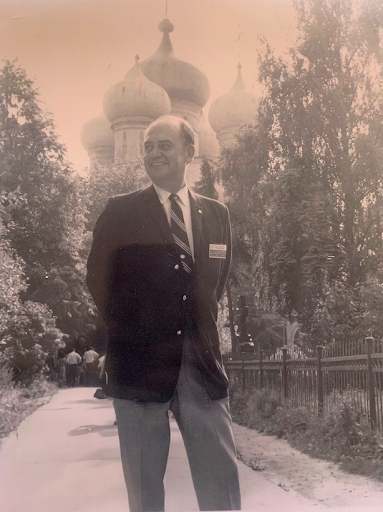Editorial Samples
Co-written, edited and oversaw placement in national and statewide publications.
Region resilience wins again
If you’re looking for high quality of life, low cost of living, a pro-business climate ranked number one in the Midwest, and an outdoor environment sporting Great Lakes beauty, Northwest Indiana belongs at the top of your list. The explosion of opportunity couldn’t be more apparent on this side of the Hoosier border, where the Region’s magnetic appeal for people to visit, buy or build a home, and locate or grow a business is resulting in real population growth.
In fact, despite a global pandemic, the Region’s resilience has created such optimism it has propelled our state to an enviable position of strength. County unemployment rates in the Region stand at all-time lows, and Indiana’s unemployment rate is lower than every state we touch, lower than the national average, and the lowest in 46 years.
Our state’s top-ranked business and regulatory environment combined with Northwest Indiana’s ideal location and quality of life are now attracting businesses to make the move and invest in Region communities like never before. Over the last few years, I’ve been excited to join local officials and business leaders from companies – including Domino’s, Alliance Steel and Midwest Truck, to name a few – as they moved to Northwest Indiana and committed to creating hundreds of quality careers, further driving up growth and opportunity in the years ahead.
It’s just a fact. Businesses don’t have to look far to discover Region grass is truly greener.
Want the proof? Indiana continues to make history and break our all-time investment and career commitment records, including last year. In 2021, the Indiana Economic Development Corporation assisted 56 new business startups in Northwest Indiana, and 287 companies committed to moving to or growing in our state. These commitments will bring 31,710 Hoosier careers to Indiana, with an average wage over $28 an hour over the upcoming years.
We welcome them all and look forward to our win-win partnership.
After all, our state’s strong revenue gives us the opportunity to further invest directly in our people and communities. While neighboring Illinois, Ohio and Michigan lost residents, Indiana’s population continued to grow. With a hot housing market, abundant amenities and career opportunities here on Hoosier soil, people and businesses from other states are fleeing, and flocking to Indiana and specifically the Region. Purposeful state and local investments, like in modern infrastructure projects and quality of place will further propel the Region to even greater heights.
And it’s becoming easier to travel to and from Northwest Indiana communities, just as it’s already become more attractive to stay.
That’s why we’re continuing to invest in the overall infrastructure platform that connects us to each other and a world of opportunities by building out our top-ranked infrastructure and implementing a fully-paid-for 20-year roads and bridges program.
Since 2017, INDOT has invested more than $395 million in highway projects and $283 million in local infrastructure projects in Northwest Indiana alone. Travel lanes have been added on I-65 between Merrillville and Lowell and a new interchange constructed at U.S. 20 and State Road 2 in La Porte County.
And while all roads are increasingly leading to Indiana, the way the Region is leveraging its lakeshore location couldn’t be more relevant to its growing appeal. Visiting Indiana Dunes, it’s easy to see why this picturesque park – rightfully our state’s first national park – is making waves, attracting well over 2 million visitors a year to enjoy more than 15,000 acres of Hoosier beaches, trails, forests and wildlife habitats along the blue water and scenic sands of the Lake Michigan shore.
Speaking of getting outdoors, the Region is blazing new trails with the support of Indiana’s Next Level Trails program, the largest infusion of state trail funding in Hoosier history.
Crown Point and Schererville put a $2.9 million state grant to work on the Pennsy Greenway Northwest Trail, with the goal of connecting Crown Point, Schererville and Munster with Lansing, Illinois. Hebron received more than $300,000 to add nearly a mile to the Veterans Memorial Parkway Trail system between Hebron and Crown Point. In Burns Harbor, $1.7 million was awarded to extend the Marquette Greenway between Hebron and Portage as part of a future multi-state trail along the Region’s Lake Michigan shore, linking with Chicago and Michigan.
Whether you’re walking, hiking, or biking, Northwest Indiana communities have never been more connected to each other, but we’re full steam ahead to build even stronger connections.
The essential infrastructure that connects our lives, livelihoods and leisure is increasingly the kind that enables downloads on our digital devices. That’s why we’ve made the largest broadband investment in our state’s history to provide everyone, everywhere in Indiana, with access to affordable, quality broadband – and the endless opportunities it affords – regardless of where you live, work, play, study or stay.
And let’s not forget, construction is underway on two of the nation’s most transformational commuter rail projects: double tracking the South Shore Line to better connect Michigan City, Gary and Chicago – and linking the West Lake Corridor from Hammond to Dyer. Beyond the reduced travel and wait times they’ll deliver, these monumental projects are on track to drive the Region forward by attracting $2.3 billion in private investment to Northwest Indiana, with 6,000 new jobs and $3 billion in economic impact projected to follow over the next several decades.
With so much opportunity in the pipeline, there’s never been a better time to double down and invest directly in our vibrant, affordable communities and the enhanced quality of place that will propel Northwest Indiana’s growth in years ahead.
That’s why, last year, with legislative support, Indiana launched our $500 million Regional Economic Acceleration and Development Initiative (READI) program, the largest investment in Hoosier history aimed at helping communities throughout our state collaborate and drive their economic growth to the next level. Northwest Indiana received full funding, $50 million, leveraging up to an additional $672 million in local and private dollars to push and power the projects forward that will enhance quality of life, attract talent and further unleash the entrepreneurial spirit that created the Region in the first place.
By investing in Northwest Indiana’s natural advantages, connecting our communities to the world and unlocking the unlimited opportunities available, the Region will continue to be the very definition of a compelling destination in the decades to come.
Looking out on the Hoosier horizon, it couldn’t be more crystal clear: the sun is rising on a renaissance of Region relevance to our state and nation.
Congress, we've got your back on Immigration
Indiana has about 220,000 open jobs right now and Utah has 107,000, according to the most recent federal data—about 6.5% of all jobs in both states. With strong business and tax environments, we like our chances in the competition for job seekers moving from other states. But they won’t be enough to fill all of those vacancies. We also need immigrants who are ready to work and help build strong communities.
To help us do our jobs as governors, we call on Congress to end its two-decade hiatus on setting immigration policy—one of its most basic duties. And we pledge to share the accountability. Border security is non-negotiable, a requirement of national security in a world with drug cartels and terrorists. But the larger standoff on immigration hobbles both parties and, more seriously, endangers America’s long-term well-being.
A growing, bipartisan group of senators appears to share our sense of urgency. But loud voices on one side still call unregulated immigration a sign of compassion—even though there are few greater cruelties than encouraging people to take dangerous journeys that end, at best, in legal limbo. Meanwhile, loud voices on the other side call immigrants a burden, against all the evidence from economics and history.
The United States became prosperous because many immigrants saw our beacon and seized the freedoms and opportunities offered here. That formula has not changed. As of 2021, for example, nearly half of America’s Fortune 500 companies had been founded by an immigrant or the child of one. Their other contributions are equally amazing.
Julian Diaz entered the U.S. in search of work in the 1990s. His son Juan now employs four other Hoosiers in a successful landscaping business. And in the third generation, Julian’s grandson Juan is a junior in computer science at Purdue University, bound (Governor Holcomb hopes) for one of the many unfilled jobs in Indiana’s burgeoning technology sector.
Bassam Salem, born in Egypt, came to the U.S. more than 30 years ago with his parents, who were international students. Even though he grew up in Utah, his immigration status limited his employment options. But he persevered, working hard to prove himself worthy of visa sponsorship by a Utah employer. The full journey took decades, but Bassam finally secured permanent residency, became a U.S. citizen, and founded two successful technology start-ups that have contributed millions to the economy.
Rapidly declining birth rates and accelerating retirements across the U.S. mean that our states’ already wide job gaps will grow to crisis proportions without more Diaz and Salem families—causing our growth engines to sputter. Many of these jobs require the skills Juan is learning and the entrepreneurial spirit Bassam developed. But many are also entry-level, low-skilled roles—essential in agriculture, health care (in particular to meet the demand for long-term care), and the service industries.
So, count us as supporters of immigration sponsorship by the states. Under such authority, which employers and universities already have, each state could make its own decisions. They could sponsor no visas or many visas each year (up to a limit set by Congress) for the specific sorts of jobs they need to fill.
Immigration sponsorship would give states a dynamic means to attract new residents—both from a pool of new applicants and from the ranks of current asylum seekers—while expanding the states’ responsibility for the contributions and success of these folks in American life.
Washington would need to grant us such authority. And Washington, of course, needs to do several more things after two decades of punting. There is no way around an approach to immigration with three basic components: rules to determine who can come in and how, and who can stay; unflinching enforcement of such rules; and a kind of review-and-repeat process that assures that the U.S. offers paths to citizenship based on our evolving needs.
The rules must include a practical approach to illegal immigrants who came to the U.S. as children. And enforcement must include firm control of all entry points. In anything resembling the real world, Republicans must make their peace with the former and Democrats with the latter.
Perhaps it will help our representatives in Washington to know that governors and many other people back home in the states have their backs. The two of us are not unicorns, and we will encourage others to step out of the forest at this week’s National Governors Association meeting.
Our southwestern states bear the brunt of today’s immigration catastrophe—needing to house, clothe, and feed an unrelenting stream of people. But in meaningful ways, every U.S. state shares a border with the rest of the world and needs investment, markets—and people—from abroad. That border can remain an embarrassment or become a big asset to us once again.
Mr. Holcomb is the governor of Indiana and Mr. Cox is the governor of Utah.
Extending Hoosier hospitality beyond borders
As the world watches Vladimir Putin relentlessly attack Ukraine, killing children and civilians, bombing a maternity ward, firing on a nuclear energy plant, and bombarding Mariupol among other cities, Hoosiers are sending prayers. Those include mine. But our Hoosier humanitarian efforts will extend far beyond the ongoing prayers and community vigils.
I’m traveling this week to Slovakia and part of my mission is to visit a refugee camp with Adjutant General, Maj. Gen. R. Dale Lyles to learn firsthand what Hoosiers can do to help. In the meantime, I met with Ukrainian Ambassador Oksana Markarova, and she requested:
• Federal assistance to secure more military equipment
• Humanitarian aid and supplies, such as gas and oil and first aid kits
• A statement of support of Ukraine and condemnation of Russia
• Ceasing of Indiana investments in Russian stocks or bonds
• Indiana businesses to halt operations with Russian entities
I shared with her that Indiana is unequivocally standing with, by, and for a free Ukraine and would address each of her requests. We have already taken these steps:
• Proceeded with divesting of more than $147 million in state government investments that have Russian interest
• Verified no public universities offer Russian-funded programs
• Supported the Indiana Gaming Commission in its suspension of leagues with Russian and Belarussian ties from the approved events for sports wagering
• Offered to temporarily or permanently house screened and processed Ukrainian refugees should the U.S government need a safe haven for them
• Offered to house and train the Ukranian Summer Olympic Team
• Asked all Hoosiers doing business in Russia to consider the moral ramifications during such a volatile time
Indiana companies have stepped up. Eli Lilly has moved a million doses of insulin into Poland, ready to make its way into Ukraine, and halted exports of non-essential medicines to Russia. Franciscan Health hospitals have collected and sent more than 100,000 pounds of medical supplies and Cummins indefinitely suspended the company’s commercial operations in Russia.
Our efforts alone won’t be enough, but we will contribute. Indeed, the world must be clear in words and even more so in actions. America must be a full partner in the E.U. mission to impose economic and individual sanctions against Putin’s killing machine. In my opinion, Russia’s “most favored nation” status was forfeited when it invaded Ukraine and threatened nuclear and chemical war. Only four nations occupy official state-sponsored terrorism status — North Korea, Syria, Iran and Cuba. After weeks of targeting civilians, Russia should make it five.
In Putin’s last days, he must know the free world will continue to answer Ukrainian President Volodymyr Zelensky’s call for more humanitarian and political support. The free world must do whatever it takes for however long it takes.
And Putin must know that for many of the same reasons the Soviet empire collapsed before, it will again, and this time on his greedy watch. He must know, this time, the world will not nod “yes” to his engulf and devour mentality but applaud those courageous souls in Moscow who have taken to the streets in protest.
The good people of Russia must know that we don’t seek war but demand peace. The world must know that this is a time of choosing. Stand for the free democratic nation of Ukraine or stand against those of us who do.
If they don’t, Eastern European maps will be redrawn once again. Gone will be the days that allowed the trip like the one my grandfather took nearly 50 years ago when he visited Moscow on business and believed the Russian government loved their children, too.

Gov. Eric Holcomb and Sec. Brad Chambers meet with Ukrainian Ambassador Oksana Markarova in Washington D.C. on March 9, 2022.

Gov. Eric Holcomb meets with Chief of Defense General Daniel Zmeko of the Slovak Armed Forces at the Indiana Statehouse on February 21, 2022.
